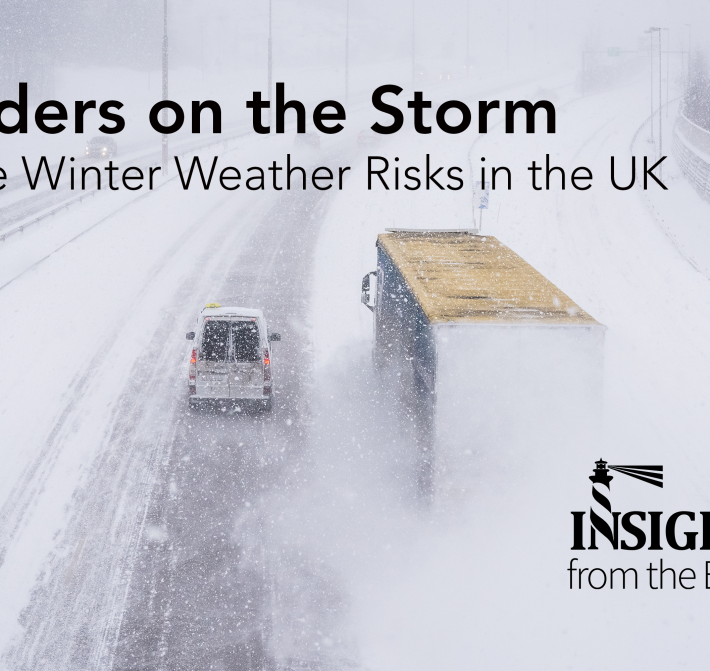
It’s now December and we are having a bit of a cold snap in North Yorkshire. Winter is with us, but how bad will it be?
In recent days an independent online weather forecasting service has issued some dire predictions about the polar weather and blizzards we can expect around Christmas. The Met Office then repudiated this and suggested that it is more likely to be overall a wet and fairly mild end to the year. Since talking about the weather is our national hobby, we thought we’d review the winter weather risks and see how they are modelled for emergency managers.
Most readers will remember at least some parts of the school geography syllabus; perhaps including the bit about how we have a relatively mild maritime climate – with winters that are typically less severe than our continental neighbours are used to and have to prepare for every year. But climate change is a fact, and the National Risk Register makes it clear that we can expect 'more frequent extreme weather events'. UK emergency managers have two main winter weather risks to think about. The first is a period low temperatures and heavy snow. The second is storms. The latter can happen at other times of the year, of course, but is usually associated with the period October to March.
The low temperatures and heavy snow risk is shown in the National Risk Register up in the top-right of the grid – a very high risk. When the next edition is published you will find that it will have been downgraded to a moderate risk. What does it look like? The reasonable worst case scenario is a multi-regional period of snow lasting 7 days, with mean temperatures of -3°C. Snow will lie between 10-30 cm deep or more. If you’ve ever lived in a country with “real” winters you be might rolling your eyes at this point. But the fact is that our systems are much less “hardened” against severe winter weather because we don’t get it that often. Not so far, at least. The impacts of an event like this can be easily imagined. The context, of course, is a nation which is ill-equipped to deal with it but also critically dependent on just-in-time supply chains. We can expect a high level of disruption to all forms of transport and distribution, coupled with electricity failures, water and sewerage outages and some shortages of essential supplies like food and fuel. It would (according to the National Risk Register) likely involve a “large number” of excess deaths (above the winter norm), severe disruption of essential services and, through business disruption, significant economic damage.
The reference cases are relatively recent and you will probably remember them. The 2018 'Beast from the East”'is the most recent. Before that the best example is December 2009-January 2010 – which saw sustained below-zero temperatures and snow lying up to 30 cm deep. What you won’t find in there as a reference case is the last 'Big Freeze' – the winter of 1962-63. This was much more severe than the current scenario. Snow lay on the ground from mid-December through to April and the sea froze up to four miles out. The first day of 1963 without a frost was 6th March! It is still, to some extent, in the national folk-memory – but what is less well remembered is that 1946-47 was almost as bad. But, winters like those are nevertheless very rare events and the chances of it happening in the rolling timeframe used in emergency risk assessments must be quite low. The reduction in that rolling timeframe from 5 years to 2 years might explain why this risk has been downgraded – the shorter the period, the less likely it is to happen (in that period).
The storms risk (formerly called storms and gales) models storm force wind (gusting up to 85 mph) across multiple UK regions for about a day. The physical damage this would cause is the issue. We could expect disruptions in power, communications, all forms of transport and extensive damage to houses and buildings. Outages could last for up to 5 days. There will probably be significant numbers of casualties and some deaths, but the biggest and most lasting impacts will be on the environment and the economy.
Again, the reference case history is relatively recent. The still-famous wind storm of October 1987 is a good example, although most people remember it now for the hapless weather forecaster who categorically dismissed it only hours before it hit. There were dozens of deaths and 15 million trees were brought down. 47 people died in the 'Burn’s Day' storm of 1990. In 2013 the St Jude storm killed four people and left nearly a million homes without electricity.
In both cases, storms and snow, things get even more interesting when you consider the range of other risks that are linked to them. Linked risks are ones that can cause each other, but there are also compound risks; these aren’t caused by each other but can make the impacts worse and more enduring – if they are at least nearly simultaneous. So, the question is - what happens when either of these main risks is associated with flooding, pandemic flu, industrial action (such as by fuel tanker drivers), gas and/or electricity failure or the business failure of a major social care provider?
Having said that we are a nation that is less resilient than some in the face of winter weather, we should acknowledge that our warning, public information and forecasting mechanisms are very good. The Met Office, for example, operates a Severe Weather Warning System.
The Met Office website is (ahem) awash with useful information, which can also be accessed by phone on 0370 900 0100. Option 1 (weather enquiries) actually gets you through to a real person!